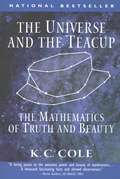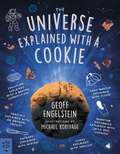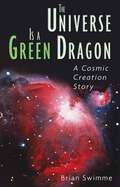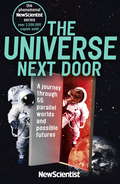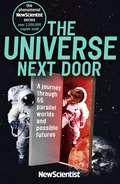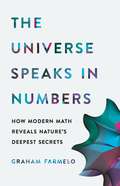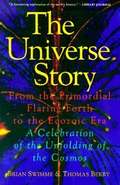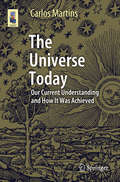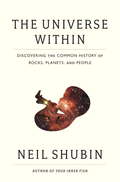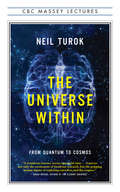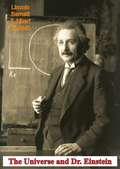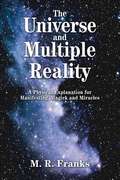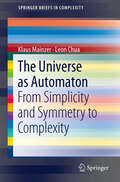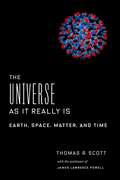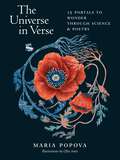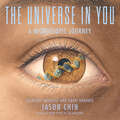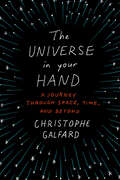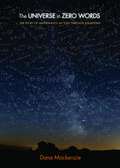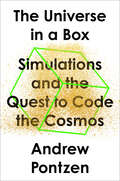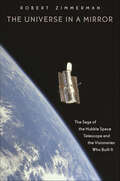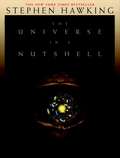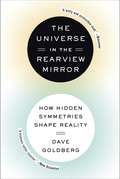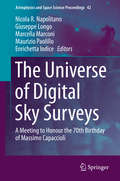- Table View
- List View
The Universe And The Teacup: The Mathematics of Truth and Beauty
by K. C. ColeFilled with “a thousand fascinating facts and shrewd observations (Martin Gardner, Los Angeles Times), this “beguiling and lucid book” (San Francisco Chronicle) demonstrates how the truth and beauty of everything, from relativity to rainbows, is all in the numbers. Line drawings.
The Universe Explained with a Cookie: What Baking Cookies Can Teach Us About Quantum Mechanics, Cosmology, Evolution, Chaos, Complexity, and More
by Geoff EngelsteinDid you know that the number of atoms in a cookie is about the same number of stars in the universe? Geoff Engelstein tackles the big questions of the universe and how it works using the sweet and simple chocolate cookie as guide. By exploring what goes into the cookie—the ingredients and the steps—we learn about how everything works, from the tiny world of subatomic particles to galactic clusters. Topics include: The Big Bang Explained with Chocolate ChipsQuantum Mechanics Explained with Milk and CookiesChaos Explained with VanillaAnd more!Filled with fascinating facts and laugh-out-loud moments, it's a richly visual and deeply fascinating scientific exploration of the world. And cookies.
The Universe Is a Green Dragon: A Cosmic Creation Story
by Brian SwimmeCommunicating his ideas in the form of a classical dialogue between a youth and a wise elder, cosmologist Brian Swimme crafts a fascinating exploration into the creativity suffusing the universe. His explication of the fundamental powers of the cosmos is mystical and ecstatic and points directly to the need to activate one&’s own creative powers.
The Universe Next Door: A Journey Through 55 Parallel Worlds and Possible Futures
by New ScientistIt's lucky you're here. But for a series of choices, accidents and coincidences - any of which could have gone otherwise - your life would have been very different. The same goes for reality. We live in just one of many possible worlds - but we can imagine parallel universes in which dinosaurs still rule the Earth, the Russians got to the moon first, everyone's a vegetarian or time itself flows backwards. And that's just for starters. What if the laws of physics were different? What if robots become smarter than us? Or, if every human on the planet simply vanished tomorrow? The answers to these questions aren't just fun to consider, but reveal deep truths about our own universe.Join New Scientist on a thrilling journey through dozens of incredible but perfectly possible alternative realities, thought experiments and counterfactual histories - each shining a surprising and unexpected spotlight on life as we know it.
The Universe Next Door: A Journey through 55 Alternative Realities, Parallel Worlds and Possible Futures
by New ScientistA journey through 55 alternative realities, parallel worlds and possible futures.It's lucky you're here. But for a series of incredible coincidences and roads not taken, your life could be very different. The same goes for reality. We live in just one of many possible worlds. In others, dinosaurs still rule the Earth, the Russians got to the Moon first, time flows backwards and everyone is vegetarian.And that's just for starters. What if the laws of physics were different? If we really did live in a multiverse? If robots became smarter than us? If humans were wiped off the face of the planet?Join New Scientist on a thrilling journey through these and dozens of other incredible but perfectly possible alternative realities, thought experiments and counterfactual histories -each shining a surprising and unexpected spotlight on life as we know it.
The Universe Speaks in Numbers: How Modern Math Reveals Nature's Deepest Secrets
by Graham FarmeloHow math helps us solve the universe's deepest mysteries One of the great insights of science is that the universe has an underlying order. The supreme goal of physicists is to understand this order through laws that describe the behavior of the most basic particles and the forces between them. For centuries, we have searched for these laws by studying the results of experiments. Since the 1970s, however, experiments at the world's most powerful atom-smashers have offered few new clues. So some of the world's leading physicists have looked to a different source of insight: modern mathematics. These physicists are sometimes accused of doing 'fairy-tale physics', unrelated to the real world. But in The Universe Speaks in Numbers, award-winning science writer and biographer Farmelo argues that the physics they are doing is based squarely on the well-established principles of quantum theory and relativity, and part of a tradition dating back to Isaac Newton. With unprecedented access to some of the world's greatest scientific minds, Farmelo offers a vivid, behind-the-scenes account of the blossoming relationship between mathematics and physics and the research that could revolutionize our understanding of reality. A masterful account of the some of the most groundbreaking ideas in physics in the past four decades. The Universe Speaks in Numbers is essential reading for anyone interested in the quest to discover the fundamental laws of nature.
The Universe Story: From the Primordial Flaring Forth to the Ecozoic Era-- A Celebration of the Unfolding of the Cosmos
by Thomas Berry Brian SwimmeThe Universe Story unites science and the humanities in a dramatic exploration of the unfolding of the universe, humanity's evolving place in the cosmos, and the boundless possibilities for our future.
The Universe Today: Our Current Understanding and How It Was Achieved (Astronomers' Universe)
by Carlos MartinsStarting out from humankind's earliest ideas about the cosmos, this book gives the reader a clear overview of our current understanding of the universe, including big bang theories and the formation of stars and galaxies, as well as addressing open questions. The author shows how our present view gradually developed from observations, and also how the outcome of ongoing research may still change this view. The book brings together concepts in physics and astronomy, including some history in both cases. The text is descriptive rather than technical: the goal is to present things rigorously and without oversimplification, by highlighting the crucial physical concepts. The only prerequisite is a qualitative knowledge of basic physics concepts at high-school level.
The Universe Within
by Neil ShubinFrom one of our finest and most popular science writers, the best-selling author of Your Inner Fish, comes the answer to a scientific mystery story as big as the world itself: How have astronomical events that took place millions of years ago created the unique qualities of the human species?In his last book, Neil Shubin delved into the amazing connections between human anatomy--our hands, our jaws--and the structures in the fish that first took over land 375 million years ago. Now, with his trademark clarity and exuberance, he takes an even more expansive approach to the question of why we are the way we are. Starting once again with fossils, Shubin turns his gaze skyward. He shows how the entirety of the universe's 14-billion-year history can be seen in our bodies. From our very molecular composition (a result of stellar events at the origin of our solar system), he makes clear, through the working of our eyes, how the evolution of the cosmos has had profound effects on the development of human life on earth.From the Hardcover edition.
The Universe Within: From Quantum to Cosmos (The CBC Massey Lectures)
by Neil TurokWinner of the Lane Anderson Award, longlisted for the Charles Taylor Prize, shortlisted for the Libris Award for Non-Fiction and selected as an Amazon.ca Best Book "With [The Universe Within’s] deeply thoughtful reflections on the place of science in society, on the need to educate the underserved, and on plenty of other topics rarely addressed in this sort of book, Turok takes you where no physicist has gone before. It’s well worth making the journey with him." — TIME Magazine The most anticipated nonfiction book of the season, this year's Massey Lectures is a visionary look at the way the human mind can shape the future by world-renowned physicist Neil Turok. Every technology we rely on today was created by the human mind, seeking to understand the universe around us. Scientific knowledge is our most precious possession, and our future will be shaped by the breakthroughs to come. In this personal, visionary, and fascinating work, Neil Turok, Director of the Perimeter Institute for Theoretical Physics, explores the transformative scientific discoveries of the past three centuries — from classical mechanics, to the nature of light, to the bizarre world of the quantum, and the evolution of the cosmos. Each new discovery has, over time, yielded new technologies causing paradigm shifts in the organization of society. Now, he argues, we are on the cusp of another major transformation: the coming quantum revolution that will supplant our current, dissatisfying digital age. Facing this brave new world, Turok calls for creatively re-inventing the way advanced knowledge is developed and shared, and opening access to the vast, untapped pools of intellectual talent in the developing world. Scientific research, training, and outreach are vital to our future economy, as well as powerful forces for peaceful global progress. Elegantly written, deeply provocative, and highly inspirational, The Universe Within is, above all, about the future — of science, of society, of ourselves.
The Universe and Dr. Einstein
by Lincoln Barnett Albert EinsteinTHE SEARCH FOR TRUTHThis is a brilliant, readable and clear report, by a gifted journalist, of the significance of Einstein's theories and their far reaching effect upon the modern world. Written for laymen, it penetrates the realms of space, explains the facts available on the nature of atoms, and merges for purposes of clarity, the relation between philosophy and modern science.Utilizing the theories of Newton, Planck, Gamow, Lemaitre and Jeans, Barnett explains the Einstein concept of the universe. Relating these scientific theories to the philosophical systems existing at the time, he shows how all forms of human activity are influenced by the discoveries of science, and how Einstein's theories are a step in this long history of research."Everybody who has a mind, or who imagines he is a thinker, should understand this much of Relativity as a minimum."--Philip Wylie"The Universe and Dr. Einstein sets a new standard in science writing and is, I think, the first American book that can be compared in maturity, clarity, and grace with the distinguished and influential works of Sir James Jeans and Sir Arthur Eddington."--Gerald Wendt, N. Y. Herald Tribune Book Review"I do not see how Lincoln Barnett could have done a more skillful job in his attempt to get a reasonably popular yet valid sketch of the philosophical concepts which physical experiments of this century have forced on science."--Karl T. Compton, Massachusetts Institute of Technology
The Universe and Dr. Einstein
by Lincoln BarnettAcclaimed by Einstein himself, this is among the clearest, most readable expositions of relativity theory. It explains the problems Einstein faced, the experiments that led to his theories, and what his findings reveal about the forces that govern the universe.
The Universe and Multiple Reality: a Physical Explanation of Manifesting, Magic and Miracles
by M. R. FranksPostulating the many-worlds interpretation of quantum physics and the reality of mind apart from the physical brain, Franks asserts that physics explains various paranormal phenomena.
The Universe as Automaton
by Klaus Mainzer Leon ChuaThis Brief is an essay at the interface of philosophy and complexity research, trying to inspire the reader with new ideas and new conceptual developments of cellular automata. Going beyond the numerical experiments of Steven Wolfram, it is argued that cellular automata must be considered complex dynamical systems in their own right, requiring appropriate analytical models in order to find precise answers and predictions in the universe of cellular automata. Indeed, eventually we have to ask whether cellular automata can be considered models of the real world and, conversely, whether there are limits to our modern approach of attributing the world, and the universe for that matter, essentially a digital reality.
The Universe as It Really Is: Earth, Space, Matter, and Time
by Dr Thomas R. ScottThe universe that science reveals to us can seem far outside the comfort zone of the human mind. Subjects near and far open up dizzying vistas, from the infinitesimal to the colossal. Humanity, the unlikely product of uncountable coincidences on unimaginable scales, inhabits a tumultuous universe that extends from our immediate environs to the most distant galaxies and beyond. But when the mind balks at the vertiginous complexity of the universe, science unveils the elegance amid the chaos.In this book, Thomas R. Scott ventures into the known and the unknown to explain our universe and the laws that govern it. The Universe as It Really Is begins with physics and the building blocks of the universe—time, gravity, light, and elementary particles—and chemistry’s ability to explain the interactions among them. Scott, with the assistance of James Lawrence Powell, next tours the earth and atmospheric sciences to explain the forces that shape our planet and then takes off for the stars to describe our place in the cosmos. He provides vivid introductions to our collective scientific inheritance, narrating discoveries such as the shape of the atom and the nature of the nucleus or how we use GPS to measure time and what that has to do with relativity. A clear demonstration of the power of scientific reasoning to bring the incomprehensible within our grasp, The Universe as It Really Is gives an engrossing account of just how much we do understand about the world around us.
The Universe in Verse: 15 Portals to Wonder through Science & Poetry
by Maria PopovaIn this book of illustrated essays, Maria Popova, creator of The Marginalian, presents a celebration of the human search for truth and beauty through the lenses of science and poetry. Poetry and science, as Popova writes in her introduction, "are instruments for knowing the world more intimately and loving it more deeply." In 15 short essays on subjects ranging from the mystery of dark matter and the infinity of pi to the resilience of trees and the intelligence of octopuses, Popova tells the stories of scientific searching and discovery. These stories are interwoven with details from the very real and human lives of scientists—many of them women, many underrecognized—and poets inspired by the same questions and the beauty they reveal. Each essay is paired with a poem reflecting its subject by poets ranging from Emily Dickinson, W. H. Auden, and Edna St. Vincent Millay to Maya Angelou, Diane Ackerman, and Tracy K. Smith, and is stunningly illustrated by celebrated artist Ofra Amit. Together, they wake us to a "reality aglow with wonder."
The Universe in You: A Microscopic Journey
by Jason ChinJason Chin, winner of the Caldecott Medal for Watercress, dives into the microscopic building blocks of life in this companion to the award-winning Your Place in the Universe.In Your Place in the Universe, Jason Chin zoomed outward, from our planet, solar system, and galaxy to the outer reaches of the observable universe. Now, Chin reverses course, zooming in past our skin to our cells, molecules, and atoms, all the way down to particles so small we can&’t yet even measure them. Like its companion, The Universe in You is a mind-boggling adventure that makes complex science accessible and enjoyable to readers of any age.Impeccably researched, wholly engrossing, and with extensive backmatter for additional learning, The Universe in You is another knockout from the award-winning creator of Redwoods, Grand Canyon, and other distinguished works of nonfiction for young readers. A School Library Journal Best Book of the YearA Junior Library Guild Gold Standard Selection
The Universe in Your Hand: A Journey Through Space, Time, and Beyond
by Christophe Galfard"If Ms. Frizzle were a physics student of Stephen Hawking, she might have written THE UNIVERSE IN YOUR HAND, a wild tour through the reaches of time and space, from the interior of a proton to the Big Bang to the rough suburbs of a black hole. It's friendly, excitable, erudite, and cosmic."—Jordan Ellenberg, New York Times besteselling author of How Not To Be WrongQuantum physics, black holes, string theory, the Big Bang, dark matter, dark energy, parallel universes: even if we are interested in these fundamental concepts of our world, their language is the language of math. Which means that despite our best intentions of finally grasping, say, Einstein's Theory of General Relativity, most of us are quickly brought up short by a snarl of nasty equations or an incomprehensible graph. Christophe Galfard's mission in life is to spread modern scientific ideas to the general public in entertaining ways. Using his considerable skills as a brilliant theoretical physicist and successful young adult author, The Universe in Your Hand employs the immediacy of simple, direct language to show us, not explain to us, the theories that underpin everything we know about our universe. To understand what happens to a dying star, we are asked to picture ourselves floating in space in front of it. To get acquainted with the quantum world, we are shrunk to the size of an atom and then taken on a journey. Employing everyday similes and metaphors, addressing the reader directly, and writing stories rather than equations renders these astoundingly complex ideas in an immediate and visceral way. Utterly captivating and entirely unique, The Universe in Your Hand will find its place among other classics in the field.
The Universe in Zero Words
by Dana MackenzieMost popular books about science, and even about mathematics, tiptoe around equations as if they were something to be hidden from the reader's tender eyes. Dana Mackenzie starts from the opposite premise: He celebrates equations. No history of art would be complete without pictures. Why, then, should a history of mathematics--the universal language of science--keep the masterpieces of the subject hidden behind a veil?The Universe in Zero Words tells the history of twenty-four great and beautiful equations that have shaped mathematics, science, and society--from the elementary (1+1=2) to the sophisticated (the Black-Scholes formula for financial derivatives), and from the famous (E=mc2) to the arcane (Hamilton's quaternion equations). Mackenzie, who has been called "a popular-science ace" by Booklist magazine, lucidly explains what each equation means, who discovered it (and how), and how it has affected our lives.Illustrated in color throughout, the book tells the human and often-surprising stories behind the invention or discovery of the equations, from how a bad cigar changed the course of quantum mechanics to why whales (if they could communicate with us) would teach us a totally different concept of geometry. At the same time, the book shows why these equations have something timeless to say about the universe, and how they do it with an economy (zero words) that no other form of human expression can match.The Universe in Zero Words is the ultimate introduction and guide to equations that have changed the world.
The Universe in a Box: Simulations and the Quest to Code the Cosmos
by Andrew PontzenScientists are using simulations to recreate the universe, revealing the hidden nature of reality.Cosmology is a tricky science—no one can make their own stars, planets, or galaxies to test its theories. But over the last few decades a new kind of physics has emerged to fill the gap between theory and experimentation. Harnessing the power of modern supercomputers, cosmologists have built simulations that offer profound insights into the deep history of our universe, allowing centuries-old ideas to be tested for the first time. Today, physicists are translating their ideas and equations into code, finding that there is just as much to be learned from computers as experiments in laboratories. In The Universe in a Box, cosmologist Andrew Pontzen explains how physicists model the universe&’s most exotic phenomena, from black holes and colliding galaxies to dark matter and quantum entanglement, enabling them to study the evolution of virtual worlds and to shed new light on our reality. But simulations don&’t just allow experimentation with the cosmos; they are also essential to myriad disciplines like weather forecasting, epidemiology, neuroscience, financial planning, airplane design, and special effects for summer blockbusters. Crafting these simulations involves tough compromises and expert knowledge. Simulation is itself a whole new branch of science, one that we are only just beginning to appreciate and understand. The story of simulations is the thrilling history of how we arrived at our current knowledge of the world around us, and it provides a sneak peek at what we may discover next.
The Universe in a Mirror: The Saga of the Hubble Space Telescope and the Visionaries Who Built It
by Robert ZimmermanThe Hubble Space Telescope has produced the most stunning images of the cosmos humanity has ever seen. It has transformed our understanding of the universe around us, revealing new information about its age and evolution, the life cycle of stars, and the very existence of black holes, among other startling discoveries. But it took an amazing amount of work and perseverance to get the first space telescope up and running. The Universe in a Mirror tells the story of this telescope and the visionaries responsible for its extraordinary accomplishments. Robert Zimmerman takes readers behind the scenes of one of the most ambitious scientific instruments ever sent into space. After World War II, astronomer Lyman Spitzer and a handful of scientists waged a fifty-year struggle to build the first space telescope capable of seeing beyond Earth's atmospheric veil. Zimmerman shows how many of the telescope's advocates sacrificed careers and family to get it launched, and how others devoted their lives to Hubble only to have their hopes and reputations shattered when its mirror was found to be flawed. This is the story of an idea that would not die--and of the dauntless human spirit. Illustrated with striking color images, The Universe in a Mirror describes the heated battles between scientists and bureaucrats, the perseverance of astronauts to repair and maintain the telescope, and much more. Hubble, and the men and women behind it, opened a rare window onto the universe, dazzling humanity with sights never before seen. This book tells their remarkable story. A new afterword updates the reader on the May 2009 Hubble service mission and looks to the future of astronomy, including the prospect of a new space telescope to replace Hubble.
The Universe in a Nutshell
by Stephen HawkingStephen Hawking's phenomenal, multimillion-copy bestseller, A Brief History of Time, introduced the ideas of this brilliant theoretical physicist to readers all over the world. Now, in a major publishing event, Hawking returns with a lavishly illustrated sequel that unravels the mysteries of the major breakthroughs that have occurred in the years since the release of his acclaimed first book. The Universe in a Nutshell * Quantum mechanics * M-theory * General relativity * 11-dimensional supergravity * 10-dimensional membranes * Superstrings * P-branes * Black holes One of the most influential thinkers of our time, Stephen Hawking is an intellectual icon, known not only for the adventurousness of his ideas but for the clarity and wit with which he expresses them. In this new book Hawking takes us to the cutting edge of theoretical physics, where truth is often stranger than fiction, to explain in layman's terms the principles that control our universe. Like many in the community of theoretical physicists, Professor Hawking is seeking to uncover the grail of science -- the elusive Theory of Everything that lies at the heart of the cosmos. In his accessible and often playful style, he guides us on his search to uncover the secrets of the universe -- from supergravity to supersymmetry, from quantum theory to M-theory, from holography to duality. He takes us to the wild frontiers of science, where superstring theory and p-branes may hold the final clue to the puzzle. And he lets us behind the scenes of one of his most exciting intellectual adventures as he seeks "to combine Einstein's General Theory of Relativity and Richard Feynman's idea of multiple histories into one complete unified theory that will describe everything that happens in the universe." With characteristic exuberance, Professor Hawking invites us to be fellow travelers on this extraordinary voyage through space-time. Copious four-color illustrations help clarify this journey into a surreal wonderland where particles, sheets, and strings move in eleven dimensions; where black holes evaporate and disappear, taking their secret with them; and where the original cosmic seed from which our own universe sprang was a tiny nut. The Universe in a Nutshell is essential reading for all of us who want to understand the universe in which we live. Like its companion volume, A Brief History of Time, it conveys the excitement felt within the scientific community as the secrets of the cosmos reveal themselves.
The Universe in the Rearview Mirror
by Dave GoldbergA physicist speeds across space, time and everything in between showing that our elegant universe--from the Higgs boson to antimatter to the most massive group of galaxies--is shaped by hidden symmetries that have driven all our recent discoveries about the universe and all the ones to come. Why is the sky dark at night? Is it possible to build a shrink-ray gun? If there is antimatter, can there be antipeople? Why are past, present, and future our only options? Are time and space like a butterfly's wings? No one but Dave Goldberg, the coolest nerd physicist on the planet, could give a hyper drive tour of the universe like this one. Not only does he answer the questions your stoner friends came up with in college, but he also reveals the most profound discoveries of physics with infectious, Carl Sagan-like enthusiasm and accessibility. Goldberg's narrative is populated with giants from the history of physics, and the biggest turns out to be an unsung genius and Nazi holocaust escapee named Emmy Noether--the other Einstein. She was unrecognized, even unpaid, throughout most of her career simply because she was a woman. Nevertheless, her theorem relating conservation laws to symmetries is widely regarded to be as important as Einstein's notion of the speed of light. Einstein himself said she was "the most significant creative mathematical genius thus far produced since the higher education of women began." Symmetry is the unsung great idea behind all the big physics of the last one hundred years--and what lies ahead. In this book, Goldberg makes mindbending science not just comprehensible but gripping. Fasten your seat belt.
The Universe of Digital Sky Surveys
by Nicola R. Napolitano Giuseppe Longo Marcella Marconi Maurizio Paolillo Enrichetta IodiceThese are the proceedings of a meeting in honour of Massimo Capaccioli at the occasion of his 70th birthday. The conference aimed at summarizing the results from the main current and past digital sky survey projects and at discussing how these can be used to inspire ongoing projects and better plan the future ones. Over the last decades, digital sky surveys performed with dedicated telescopes and finely-tuned wide-field cameras, have revolutionized astronomy. They have become the main tool to investigate the nearby and far away universe, thus providing new insights in the understanding of the galaxy structure and assembly across time, the dark components of the universe, as well as the history of our own galaxy. They have also opened the time domain leading to a new understanding of the transient phenomena in the universe. By providing public access to top quality data, digital surveys have also changed the everyday practice of astronomers who have become less dependent on direct access to large observing facilities. The full scientific exploitation of these surveys has also triggered significant advances in both space and ground based technology and in the field of multi-object spectroscopy. The various sections of this book are devoted to different relevant aspects of astrophysics in the era of digital sky surveys and include both review and shorter, more focused contributions.
The Universe of Experience: A Worldview Beyond Science and Religion
by Lancelot WhyteModern experience forces philosophy and social thought to confront the basic problems of value. Is this life worth caring about? How can we find a way between the deceit of fanatical belief and despair? In the view of Lancelot Law Whyte, the essential challenge to mankind today is an underlying nihilism promoting violence and frustrating sane policies on major social issues. Avoiding the seductive trap of utopianism, Whyte approaches this challenge by defining the terms of a potentially worldwide consensus of heart, mind, and will.In this volume, Whyte addresses the problems of despair and fanatical religious or political reactions that arise from despair. He begins with the basic problem of nihilism, or the tendency toward pessimism and self/other destruction that faces us at this point in human development. Rejecting all forms of religious sectarianism as separating God from the individual and people from each other, he discerns, as well, a fundamental disunity and incompleteness among the sciences that render them incapable of supplying a guide to social order. Whyte sees the universe as an arena of conflict between tendencies toward order and disorder with the former dominating and containing the latter. In place of science and traditional religion, Whyte draws upon what he sees as the unconscious tradition, a genius of the community, shared in degrees by all its members, that points mankind toward a better way of living.Whyte does not posit a state of perfection, nor does he suggest the end of human suffering. Instead he suggests that an integrated state of being, freed from the old mind-body dualism will be a new starting point in human evolution. Accessibly written and firmly rooted in science, philosophy, and history, The Universe of Experience will be of interest to sociologists, psychologists, and philosophers.
